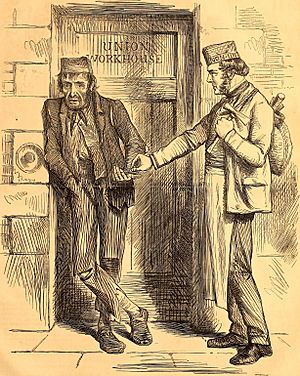Sarcasm facts for kids

Sarcasm is a figure of speech or speech comment which is extremely difficult to define. It is a statement or comment which means the opposite of what it says. It may be made with the intent of humour, or it may be made to be hurtful.
The basic meaning is to be hostile under the cover of friendliness. The word's origin is Greek, sarcasmus, see sarchasaristic (Hobson 2018). However, it usually comes with a cue which helps the receiver to understand it. For example, a mother saying "Oh, that's clever!" when a child makes a mistake always signals her love with her tone of voice. Quite different when a hostile person says "Oh, here comes Mr Clever-clogs!". So a person learns how to decode the message.
Much more difficult it is when someone uses a neutral tone of voice, as in "deadpan" or "dry humor". Psychologists think such cases are basically hostile.
A point to remember is that it does not travel well in writing or translation.
Vocal indication
In English, sarcasm is often expressed by speaking more slowly and with a lower pitch. Similarly, Dutch uses a lowered pitch; sometimes to such an extent that the expression is reduced to a mere mumble. But other research shows that there are many ways that real speakers signal sarcastic intentions. One study found that in Cantonese, sarcasm is indicated by raising the fundamental frequency of one's voice. In Amharic, rising intonation is used to show sarcasm.
Punctuation
Though in the English language there is not any standard accepted method to denote irony or sarcasm in written conversation, several forms of punctuation have been proposed. Among the oldest and frequently attested are the percontation point—furthered by Henry Denham in the 1580s—and the irony mark—furthered by Alcanter de Brahm in the 19th century. Both of these marks were represented visually by a ⸮ backwards question mark (Unicode U+2E2E). Each of these punctuation marks are primarily used to indicate that a sentence should be understood as ironic, but not necessarily designate sarcasm that is not ironic. By contrast, more recent proposals, such as the snark mark, or the use of the following tilde are specifically intended to denote sarcasm rather than irony. A bracketed exclamation point or question mark as well as scare quotes are also sometimes used to express irony or ironic sarcasm.
In certain Ethiopic languages, sarcasm and unreal phrases are indicated at the end of a sentence with a sarcasm mark called temherte slaq, a character that looks like an inverted exclamation point ¡. The usage directly parallels John Wilkins' 1668 proposal to use the inverted exclamation point as an irony mark. A proposal by Asteraye Tsigie and Daniel Yacob in 1999 to include the temherte slaq in Unicode was unsuccessful.
Sarcasm and irony
While sarcasm (harsh ridicule or mockery) is often directly associated with verbal irony (meaning the opposite of what is said) and the two are frequently used together; sarcasm is not necessarily ironic by definition, and either element can be used without the other.
Examples of sarcasm and irony used together:
"My you're early!" (After one arrives extremely late).
"What a fine artist you've become!" (When meaning to express displeasure).
Example of irony without sarcasm:
After a popular teacher apologizes to the class for answering his phone in the other room: "I don't know if we can forgive you!"
Images for kids
-
Sarcastic comment below a memorial plaque for Alois Alzheimer who first described Alzheimer's disease. The German text means "Alois, we will never forget you!", subtly playing with the contradiction between a disease deteriorating the human memory, the purpose of the memorial and the added text.
See also
 In Spanish: Sarcasmo para niños
In Spanish: Sarcasmo para niños


